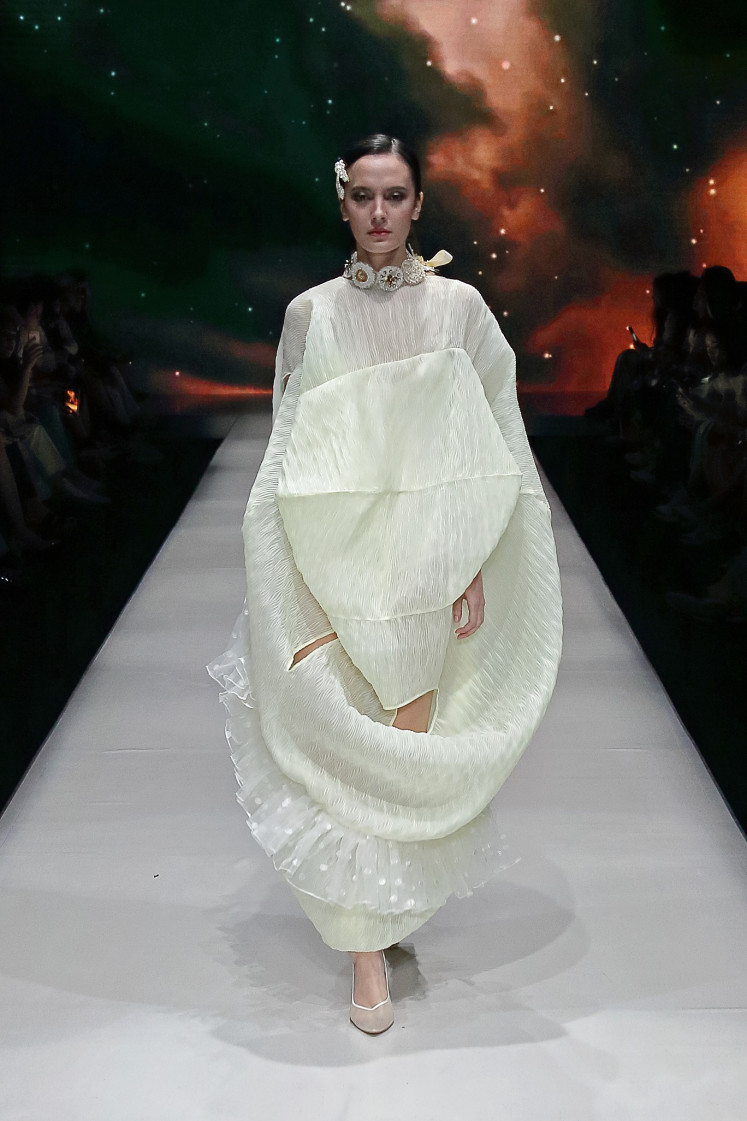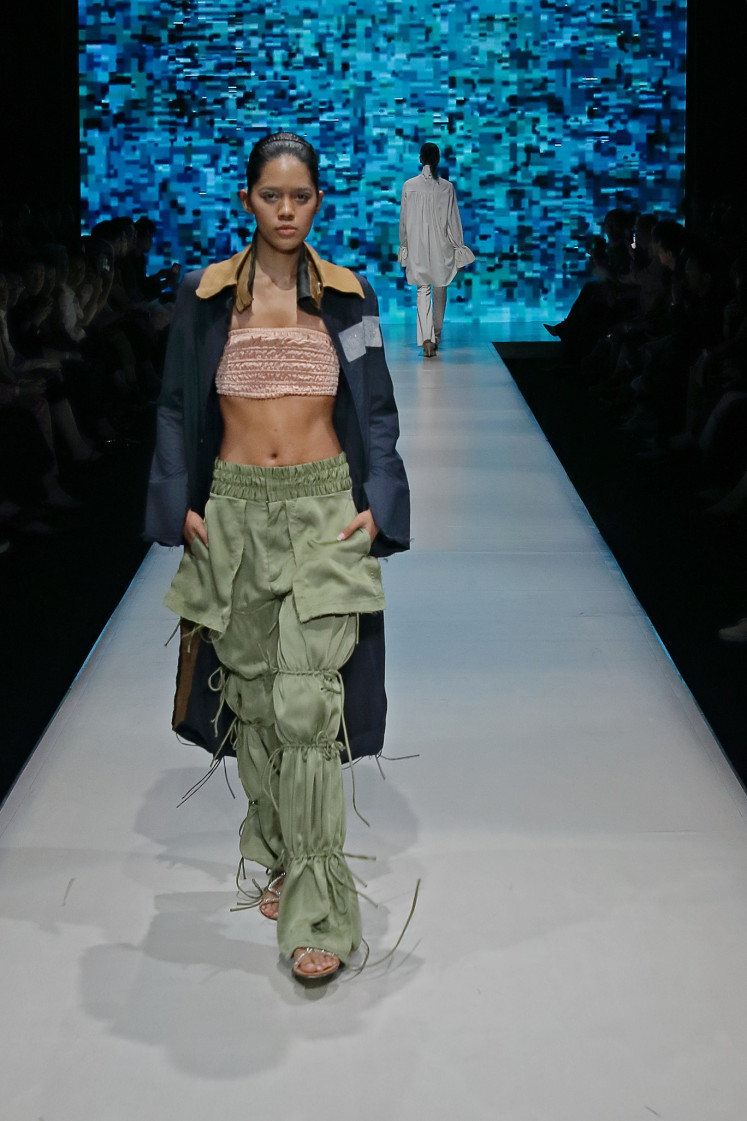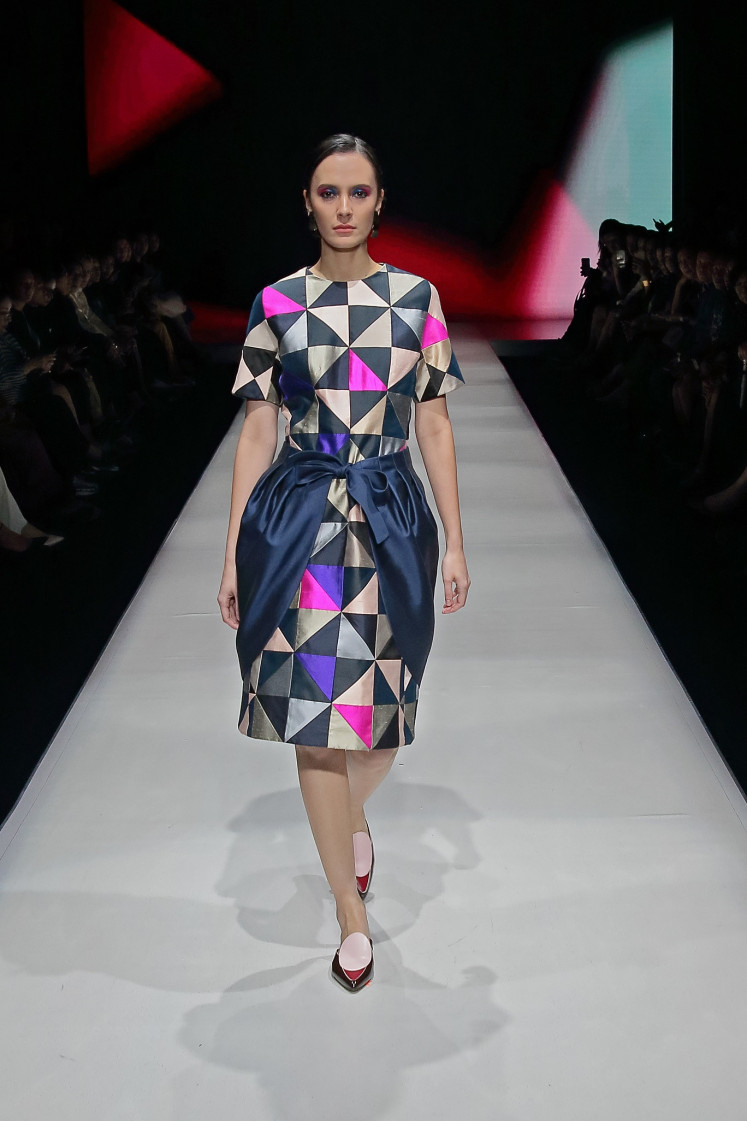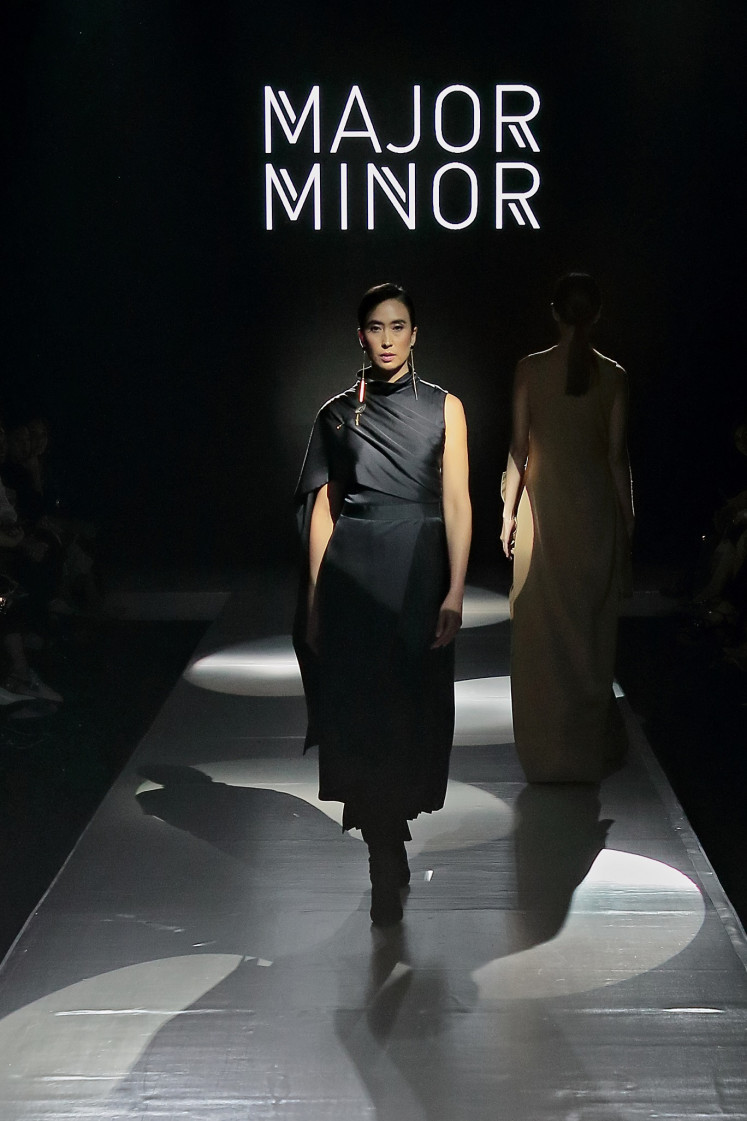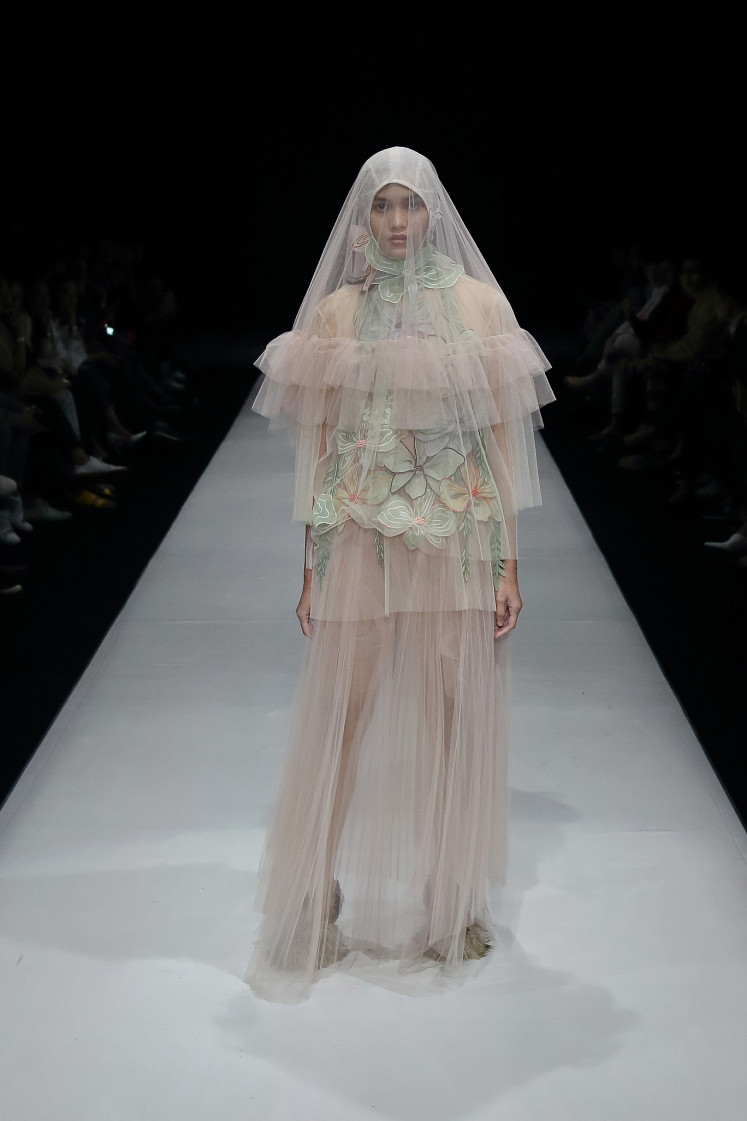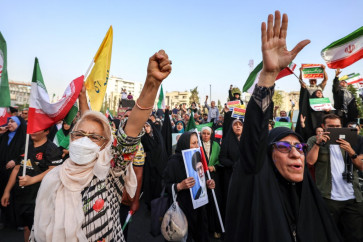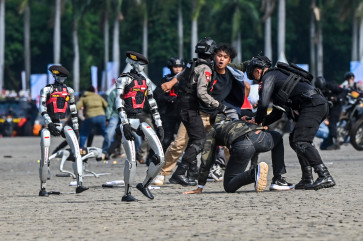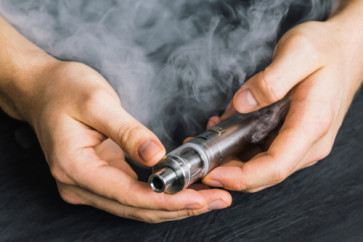Popular Reads
Top Results
Can't find what you're looking for?
View all search resultsPopular Reads
Top Results
Can't find what you're looking for?
View all search results‘The Future is Female’: When Feminism, fashion collide
What does female empowerment mean today? The emergence of antifeminist group Indonesia Tanpa Feminis (Indonesia Without Feminists) is exactly why we need to ask. We turn to fashion, the heart of today’s cultural conversation, for answers. At the recent “The Future is Female” curated show during Plaza Indonesia Fashion Week, a handful of Indonesian designers unlocked their varied visions of emancipated women.
Change text size
Gift Premium Articles
to Anyone
W
hat does female empowerment mean today? The emergence of antifeminist group Indonesia Tanpa Feminis (Indonesia Without Feminists) is exactly why we need to ask. We turn to fashion, the heart of today’s cultural conversation, for answers. At the recent “The Future is Female” curated show during Plaza Indonesia Fashion Week, a handful of Indonesian designers unlocked their varied visions of emancipated women. Some shared their bold statements with equally bold collections, while others failed to embody what a modern woman is. Here are the hits and misses from the show.
Rama Dauhan
Rama Dauhan (Plaza Indonesia Fashion Week/-)There was an interesting story to tell from Rama Dauhan’s “Intuition” collection, which took inspiration from the 1900s German painter Paula Modersohn-Becker, who delayed getting pregnant to create art.
The clothes were equally interesting, as every look was an explosion of volume in white. But how Becker had anything to do with the clothes wasn’t very apparent. Texture took center stage—Dauhan mixed ruffles, ruching, pleating, draping, and embroidery on chiffon, lace, organdie and tulle to create intense looks. They were unique, for sure.
Tangan
Tangan (Plaza Indonesia Fashion Week/-)Designers Zico Halim and Margaretha Novi know how to entertain and create experiences. The duo commissioned art director Lianggono, best known for his floral work, to create an intimate installation just outside The Warehouse of Plaza Indonesia. It contextualized the collection in a leaf-filled enclave and also invited visitors to reflect a memory by writing a postcard.
As for the clothes, the designers presented their usual fix of deconstructed garments, finished with raw hems and exposure of the female body. But this time around, it involved plenty of ruching. The collection name, “Shift”, fittingly signified their departure from the label’s signature heavy and masculine clothes to the light, flowy and feminine look this season.
Kraton
Kraton (Plaza Indonesia Fashion Week/-)One should expect nothing short of excellence from Auguste Soesastro. The silhouettes from Kraton this season are familiar as they are a continuation of previous collections' style: curved, draped and loose. It had so much potential: his inspirations were 1960s Paris couture and New York’s Studio 54.
But given the bombastic eras it referenced, the collection was understated. It needed exaggeration. The 1960s were a time of Cristobal Balenciaga’s couture cocoons, and Bianca Jagger got on a white horse at the legendary New York club. Both were iconic moments, and could have been for Soesastro.
Nevertheless, he did offer a brave palette and interesting, high-quality textiles. Fuschias clashed with greys and olives. There were rainbow-colored prints and geometric patterns on boleros, coats and dresses. Light was a major exploration, as some garments were stitched with pailettes entirely and satin was used aplenty.
Major Minor
Major Minor (Plaza Indonesia Fashion Week/-)In his “Equilibrium” collection, designer Ari Seputra was particularly looking at how Javanese royalty adopted European codes of clothing to be considered equals during the colonial Dutch era.
But it was difficult to fathom how this served as inspiration in any way to female empowerment—as was written on Major Minor’s press release. Unless he was referring to the emancipators, who were unmentioned. It was unnerving to see that none of what was written was reflected on the clothes. Added to that was the menswear-for-women-empowerment narrative, which Coco Chanel had already popularized a century ago.
We must think of female empowerment in new ways instead of repeating the patriarchal implication that power is derived from borrowing something from men. Try making clothes that actually flatter people, for starters.
Sean Sheila
There were a few subthemes in Sean Sheila’s “Apocalypse in Slow Motion”, which was a response to the decline of global wildlife. It was a hotchpotch of a collection: the palette included grey, mustard, black, navy and gold. Tailoring, sportswear, eveningwear and deconstruction collided, culminating as a big-bang of all-black looks completed with yards and yards of netting.
The husband and wife duo merged wallets, pouches and bags into the garments to create hybrids, which we’ve recently seen in Virgil Abloh’s Louis Vuitton Spring 2019 menswear collection now in stores. Perhaps they’re somewhat ideal for an apocalypse—no time or energy to be lugging stuff around. In today’s extremely mobile world, too, the idea makes practical sense.
But often, as many times in the past, Sean and Sheila had too many ideas for one look. An asymmetrical blazer-dress had an exposed sleeve, patched with PVC; one side of the shoulder pads was left as is; it was corseted and then belted. It was hard to imagine how they could be worn off the runway but definitely exciting to see how it performs editorially.
Toton
Toton (Plaza Indonesia Fashion Week/-)Toton Januar never ceases to amaze by making Indonesian heritage contemporary. This season, the Makassar-born designer offered yet another sublime vision of strength through the female gaze, borrowed from traditional dress.
The collection explores the autonomy of female desire and experience. “Notions of sensuality and sexuality are increasingly shifting to contradict Indonesian traditions and values,” he said. If a man can understand this, why can’t the rest follow suit?
With soft colors like cream, blush, coral, mint and eggshell blue—multiple colors came together to create ethereal looks. There were fluorescent touches, particularly on the pleated skirts, furry bags and shoes, and beaded PVC earrings and necklaces.
Januar also sent out matching gloves and unique headpieces in the form of veils and laced balaclavas—they matched his rationale. As for silhouettes, Januar championed dropped shoulders in tulle, organza, wool and repurposed denim.


